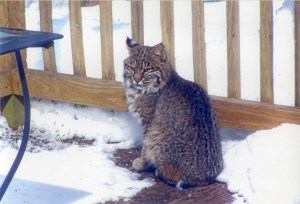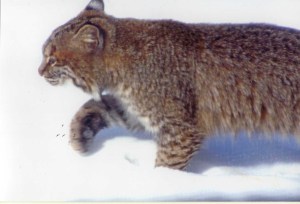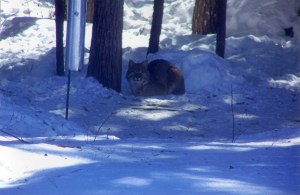NORWAY — For the past two weeks, a bobcat has sat patiently in the shadows of the trees, his small, black ear tufts pointing straight up and his hazel eyes intently watching the bird feeders in John McCormack’s back yard.
For three hours, he inches his way toward the feeder, then pounces on something in the snow.
The late winter makes for tough hunting since there’s no crust on the snow and it takes more effort for the wild felines to search for food. Bird and deer feeders — both of which McCormack has at his Norway home — attract the small prey bobcats are looking for.
“Sometimes they will watch for hours and hours so they can try and get as close as possible so they can make a sprint at (the prey) and ambush them. … They kind of confine their origin where they get more bang for their buck in a place like this where there’s a concentrated food source,” Scott Lindsay, a biologist with the Maine Department of Inland Fisheries and Wildlife in Gray, said Monday.
“By their nature they’re very secretive animals. … They are very, very good at keeping their profile to a minimum. They are generally by themselves … not like you would see a group of turkeys or a group of deer.”
McCormack discovered a pair of bobcats frequenting his wooded yard on Huntington Avenue two weekends ago.
“I looked out there Saturday (Feb. 28) and I said, ‘Wow that’s an awfully big house cat.’ It just looked like a round ball of fur sitting there,” he said. “(He’s) probably 18 to 20 inches tall, which is a good size.”
Two days later, there were two animals sitting in his yard. But they weren’t house cats, they were bobcats. The larger one is the one McCormack, his wife, Martha, and their neighbor, Thelma Denlinger, have seen most often.
“The big one started climbing the tree here. I was surprised to see two,” McCormack said, estimating the pair was about 60 feet from his house. “I’d tap on the window (and) he’d look at me.”
But Denlinger got a closer view of the larger cat and snapped photographs after he climbed up and sat on her back porch, she said last week.
Lindsay said male bobcats are much larger than females, usually weighing between 30 and 35 pounds, though there have been males that have been found weighing upward of 50 pounds. Most females average between 20 and 25 pounds.
He suspects it’s a breeding pair, as bobcats start pair bonding in January and February, with their home range spreading from 20 to 40 miles.
“If this person has seen them regularly for days at a time, they are in the area looking for potential den sites,” Lindsay said. There’s a lot of elevated ledges and rock outcroppings the animals would use for dens in Norway, he said.
The McCormacks and Denlinger might be in for a treat if the pair’s den is close by.
Lindsay said the females generally give birth at the end of April to early May in Western Maine, with an average of two to three kittens.
“They’ll see them around,” Lindsay predicted about the kittens. “(It’s) kind of like with foxes when the young are born, you will see the young more often out and about of the den. (It) could be right behind the house.”
Over the years, he’s only heard of one case of a bobcat becoming aggressive with a human. It was in Central Massachusetts and the animal was rabid and cornered in a garage.
“The only thing I would advise people when they do watch them is … if they do have small pets, I wouldn’t recommend you leave them out unattended, particularly overnight,” Lindsay said, noting house cats and small dogs are prey.



Comments are no longer available on this story